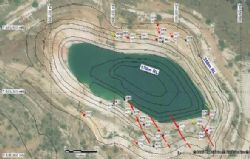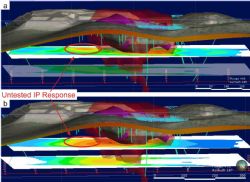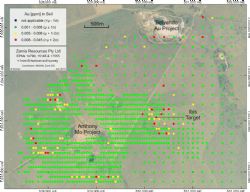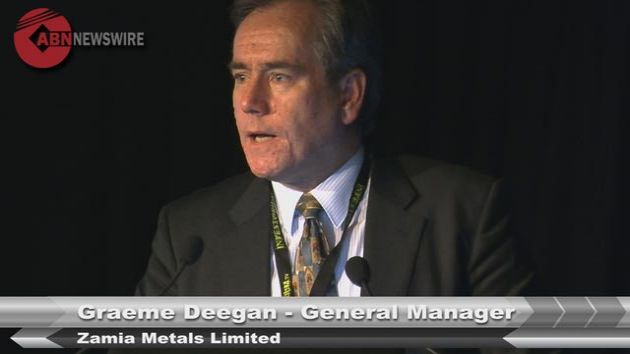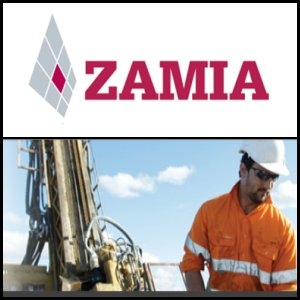 Quarterly Activities Report
Quarterly Activities Report
Sydney, July 31, 2015 AEST (ABN Newswire) - Zamia Metals Limited ( ASX:ZGM) announce the Quarterly Activities Report.
ASX:ZGM) announce the Quarterly Activities Report.
KEY POINTS
- Geological contractors Corbett, Menzies & Cunliffe ('CMC') re-asses Zamia's Belyando Gold Project
- Geochemical sampling identifies a new gold-arsenic soil anomaly to the south of Belyando
- At the Big Red Prospect, infill soil sampling defines a consistent geochemical anomaly
EPM 15145 - MAZEPPA EXTENDED
Belyando Gold Project
The Belyando Gold Project is located 75 km north of Clermont, central Queensland, within Zamia's EPM 15145 'Mazeppa Extended'. The project includes the historic open cut Belyando Gold Mine, operated by Ross Mining NL between 1989 and 1995, located less than 3 km north-east of Zamia's 'Anthony' Porphyry Molybdenum deposit. Zamia has previously reported on the geology and mineralisation of the Belyando Project (ASX ZGM 28 May 2014, 19 August 2014), and completed a drilling programme testing the potential for further mineralisation below and near the open pit in November 2014 (ASX ZGM 24 February 2015)
In April 2015, Zamia engaged geological consultant D. Menzies (Corbett, Menzies and Cunliffe) to conduct a field-based assessment of the project, which included pit mapping and logging of 1986-88 diamond core remaining at the project site. The assessment concluded that the deposit is characterised by structurally controlled quartz-sulphide style gold mineralisation related to a magmatic fluid source. Gold concentrations are focussed on a set of NW-striking fault-bounded quartz-pyrite-arsenopyrite 'reefs' exposed in the pit walls (Figure 1 & 2 in link below) and evident in drill core.
Hypogene clay alteration occurring within fault-controlled magmatic dykes suggests that mixing of metal-bearing magmatic fluids and acidic surface waters has aided gold concentration. Geological core logging indicates that elevated gold grades (>4 g/t Au compared to an average deposit grade of 1.49 g/t Au; Mustard, 1998) occur within and adjacent to zones of clay alteration. The presence of elevated gold grades associated with deposition by fluid mixing is interpreted to increase the potential for new high grade gold zones below and lateral to the current pit.
Structural mapping in the accessible southern part of the Belyando pit indicates that quartz-sulphide reefs strike north-west at a significant angle to the long section of the open pit. This observation has led to a re-interpretation of the pre-mining drilling results (Lawton, 1988; QDEX CR18140), which indicates potential for additional gold mineralisation to the south-east of the current pit. This conclusion is supported by elevated gold grades intersected by Zamia's hole RC14BY007 (ASX ZGM 24 February 2015) as well as pre-mining Induced Polarisation ('IP') geophysical data (Mustard, 1987; QDEX CR18248), showing the presence of a coincident resistivity and chargeability response that extends beyond the current pit (Figure 3).
Zamia is encouraged by the results of the external review of the project, and has prepared a new exploration programme employing geophysical surveying and drilling (ASX ZGM 30 June 2015), targeting new gold mineralisation below and lateral to the known deposit.
Regional Exploration
In April, Zamia extended the existing b-horizon soil geochemical grid surrounding to cover the area between the porphyry-style Anthony Mo deposit and the Belyando deposit with <1 mm sieved soil samples on 200m centres. Zamia collected 247 samples on EPMs 15145 and 17555, extending the sampling area to the south and in-filling the 'Ibis' target area with samples on 100m centres. All samples were pulverised to <75 µm and leached using aqua regia before assaying for gold and trace elements. Final assay results were returned in early July. Classified assay results for gold and arsenic are plotted in Figures 4 and 5 in link below.
The soil geochemistry shows a coincident gold and arsenic response, occupying an area of approximately 500m in diameter, located 1.4 km east of the Anthony deposit and 2.1 km south of the Belyando pit. The subtle >8 ppb gold anomaly, containing an isolated maximum sample of 45 ppb Au, is backed by a more substantial >17 ppm arsenic high, peaking at 45 ppm As. Both anomalies were defined using statistics of >1000 samples, assuming a log-normal distribution of assay results. The Au-As anomaly, named 'Ibis' target, is centred on a flat area devoid of outcrop, surrounded by low-lying 'gilgai' (colloquial 'melon hole') country. The anomalous soil geochemistry extends from the central area, which is considered a topographic anomaly, into the surrounding gilgai soils.
The sampling area in general is characterised by heterogeneous soil profiles comprised of silty red soils, rich in metamorphic vein quartz fragments, and clay-rich 'gilgai' or 'black' soils devoid of rock fragments. The two soil types are interpreted to be derived from Anakie Group metamorphic basement rocks, which host the mineralisation at the Belyando and Anthony Projects, and Tertiary volcanic cover rocks, respectively. The varying soil composition renders a straightforward interpretation of soil results difficult, and the resulting anomaly, while promising, requires confirmation via direct testing of bedrock geochemistry (e.g. rotary air-blast drilling).
EPM 17703 - DISNEY (BIG RED GOLD PROJECT)
Gold assaying of previously-collected soil samples showed a significant gold-in-soil response of 1.4 km strike length to the south-west of the original Big Red prospect (ASX ZGM 25 March 2015). The elevated gold assays (maximum 200 ppb Au in soil) overlie a magnetic lineament, interpreted as a tectonic structure de-magnetised by hydrothermal activity. This interpretation is consistent with a mineralised host structure observed by BMA Gold geologists during trenching in 2006 (ELP, 2008; QDEX CR52303).
In April 2015, additional sampling infilled the survey grid to a 100m x 100m sample spacing. A total of 54 b-horizon <1 mm soil samples as well as four rock chip samples (from float and sub-crop) were collected. Soil samples were pulverised to <75 µm before aqua regia digest and assaying for gold and trace elements. Sampling, processing and analytical techniques were identical to those used for the original samples taken in 2013. Final assay results were returned in early May. Gold assays for an additional 41 soil samples taken in 2013 were obtained in June. Classified gold-in-soil results for all samples are plotted in Figure 6 in link below.
The gold anomaly remains at its previously established strike length of 1.4 km but there is an internal anomaly of >35 ppb Au with a strike length of 400m, consistent with the north-east trend of the whole anomaly. The central part of the anomaly is located 500m south-west of the RC percussion drill holes completed by BMA Gold Ltd in 2006 (Figure 7 in link below).
Soils consist largely of red silty soils without significant rock chip content. Rock outcrop is limited to the north-east of the soil grid, close to the BMA Gold drill holes. Elsewhere float rock or subcrop are rare, but Zamia collected three rock chip samples within the central anomaly. All rock chips consist of fine-grained, strongly siliceous granite or rhyolite showing moderate to strong, stock-worked and fractured quartz veining. Rock samples were subjected to four-acid dissolution prior to gold and trace element analysis. Assay results are summarised in Table 1 in link below.
In summary, the geochemistry at the Big Red Prospect has identified an encouraging anomalous area of significant strike length which remains untested by drilling. Zamia proposes a programme of RAB drilling to test for near-surface gold mineralisation (ASX ZGM 30 June 2015).
To view the full report, please visit:
http://media.abnnewswire.net/media/en/docs/ASX-ZGM-869851.pdf
About Zamia Metals Limited
 Zamia Metals Limited (ASX:ZGM) is an Australian mineral exploration company, targeting the Clermont district of central Queensland, a known gold and emerging porphyry mineral province. Numerous targets for gold, copper and molybdenum have been identified by geochemical and geophysical surveys. The Clermont district is highly prospective for gold, copper and other metals including molybdenum. The Belyando Gold Project is Zamia's flagship project – potentially a porphyry-style gold deposit including historic Belyando Gold Mine
Zamia Metals Limited (ASX:ZGM) is an Australian mineral exploration company, targeting the Clermont district of central Queensland, a known gold and emerging porphyry mineral province. Numerous targets for gold, copper and molybdenum have been identified by geochemical and geophysical surveys. The Clermont district is highly prospective for gold, copper and other metals including molybdenum. The Belyando Gold Project is Zamia's flagship project – potentially a porphyry-style gold deposit including historic Belyando Gold Mine
![abnnewswire.com]()
Related Companies
Social Media
Share this Article

 ASX:ZGM) announce the Quarterly Activities Report.
ASX:ZGM) announce the Quarterly Activities Report. Zamia Metals Limited (ASX:ZGM) is an Australian mineral exploration company, targeting the Clermont district of central Queensland, a known gold and emerging porphyry mineral province. Numerous targets for gold, copper and molybdenum have been identified by geochemical and geophysical surveys. The Clermont district is highly prospective for gold, copper and other metals including molybdenum. The Belyando Gold Project is Zamia's flagship project – potentially a porphyry-style gold deposit including historic Belyando Gold Mine
Zamia Metals Limited (ASX:ZGM) is an Australian mineral exploration company, targeting the Clermont district of central Queensland, a known gold and emerging porphyry mineral province. Numerous targets for gold, copper and molybdenum have been identified by geochemical and geophysical surveys. The Clermont district is highly prospective for gold, copper and other metals including molybdenum. The Belyando Gold Project is Zamia's flagship project – potentially a porphyry-style gold deposit including historic Belyando Gold Mine



